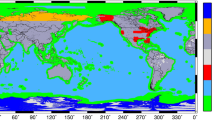Abstract
Based on a simple coupled Lorenz model, we investigate how to assess a suitable initial perturbation scheme for ensemble forecasting in a multiscale system involving slow dynamics and fast dynamics. Four initial perturbation approaches are used in the ensemble forecasting experiments: the random perturbation (RP), the bred vector (BV), the ensemble transform Kalman filter (ETKF), and the nonlinear local Lyapunov vector (NLLV) methods. Results show that, regardless of the method used, the ensemble averages behave indistinguishably from the control forecasts during the first few time steps. Due to different error growth in different time-scale systems, the ensemble averages perform better than the control forecast after very short lead times in a fast subsystem but after a relatively long period of time in a slow subsystem. Due to the coupled dynamic processes, the addition of perturbations to fast variables or to slow variables can contribute to an improvement in the forecasting skill for fast variables and slow variables. Regarding the initial perturbation approaches, the NLLVs show higher forecasting skill than the BVs or RPs overall. The NLLVs and ETKFs had nearly equivalent prediction skill, but NLLVs performed best by a narrow margin. In particular, when adding perturbations to slow variables, the independent perturbations (NLLVs and ETKFs) perform much better in ensemble prediction. These results are simply implied in a real coupled air-sea model. For the prediction of oceanic variables, using independent perturbations (NLLVs) and adding perturbations to oceanic variables are expected to result in better performance in the ensemble prediction.
摘 要
本文基于一个简单的耦合 Lorenz 模型, 探讨了多尺度模式的集合预报初始扰动构造相关问题. 集合预报试验使用了四种初始扰动方法:随机扰动 (RP)、 繁殖向量 (BV)、 集合变换卡尔曼滤波 (ETKF) 和非线性局部 Lyapunov 向量 (NLLV) 方法. 结果表明, 无论使用哪种方法, 预报的初始阶段, 集合**均与控制预报相**. 耦合 Lorenz 模型由慢系统和快系统耦合而成. 由于误差在不同时间尺度系统呈现不同的增长模态, 快系统经过较短的一段时间后, 集合**均的结果开始优于控制预报, 然而, 慢系统经过相对较长的时间后, 集合预报才开始起作用. 此外, 由于不同尺度之间的相互反馈过程, 无论是对快变量还是对慢变量叠加扰动, 都有助于提高慢系统和快系统的预报技巧. 对不同初始集合扰动生成方法进行比较, 发现 NLLVs 总体上优于 BVs 和 RPs, NLLVs 和 ETKFs 的预报能力几乎相当. 当向慢变量叠加扰动时, 独立扰动 (NLLVs 和 ETKFs) 在集合预报中表现出更好的预报技巧. 将简单模型的结果引申到真实的海气耦合模式. 我们推测, 对于海洋变量的预报, 使用独立扰动 (NLLVs) 并且在海洋变量叠加扰动, 会取得更好的集合预报效果.
Similar content being viewed by others
References
Bender, M. A., I. Ginis, R. Tuleya, B. Thomas, and T. Marchok, 2007: The operational GFDL coupled hurricane-ocean prediction system and a summary of its performance. Mon. Wea. Rev., 135, 3965–3989, https://doi.org/10.1175/2007MWR2032.1.
Bishop, C. H., B. J. Etherton, and S. J. Majumdar, 2001: Adaptive sampling with the ensemble transform kalman filter. Part I: Theoretical aspects. Mon. Wea. Rev., 129, 420–436, https://doi.org/10.1175/1520-0493(2001)129<0420:ASWTET>2.0.CO;2.
Boffetta, G., P. Giuliani, G. Paladin, and A. Vulpiani, 1998: An extension of the lyapunov analysis for the predictability problem. J. Atmos. Sci., 55, 3409–3416, https://doi.org/10.1175/1520-0469(1998)055<3409:AEOTLA>2.0.CO;2.
Brier, G. W., 1950: Verification of forecasts expressed in terms of probability. Mon. Wea. Rev., 78, 1–3, https://doi.org/10.1175/1520-0493(1950)078<0001:VOFEIT>2.0.CO;2.
Buckingham, C., T. Marchok, I. Ginis, L. Rothstein, and D. Rowe, 2010: Short- and medium-range prediction of tropical and transitioning cyclone tracks within the NCEP global ensemble forecasting system. Wea. Forecasting, 25, 1736–1754, https://doi.org/10.1175/2010WAF2222398.1.
Candille, G., and O. Talagrand, 2005: Evaluation of probabilistic prediction systems for a scalar variable. Quart. J. Roy. Meteor. Soc., 131, 2131–2150, https://doi.org/10.1256/qj.04.71.
Demeritt, D., H. Cloke, F. Pappenberger, J. Thielen, J. Bartholmes, and M.-H. Ramos, 2007: Ensemble predictions and perceptions of risk, uncertainty, and error in flood forecasting. Environmental Hazards, 7, 115–127, https://doi.org/10.1016/j.envhaz.2007.05.001.
Ding, R. Q., and J. P. Li, 2007: Nonlinear finite-time Lyapunov exponent and predictability. Physics Letters A, 364, 396–400, https://doi.org/10.1016/j.physleta.2006.11.094.
Ding, R. Q., and J. P. Li, 2012: Relationships between the limit of predictability and initial error in the uncoupled and coupled lorenz models. Adv. Atmos. Sci., 29, 1078–1088, https://doi.org/10.1007/s00376-012-1207-8.
Ding, R. Q., J. P. Li, and B. S. Li, 2017: Determining the spectrum of the nonlinear local Lyapunov exponents in a multidimensional chaotic system. Adv. Atmos. Sci., 34, 1027–1034, https://doi.org/10.1007/s00376-017-7011-8.
Dong, B. W., R. T. Sutton, L. Shaffrey, and N. P. Klingaman, 2017: Attribution of forced decadal climate change in coupled and uncoupled ocean-atmosphere model experiments. J. Climate, 30, 6203–6223, https://doi.org/10.1175/JCLI-D-16-0578.1.
Ehrendorfer, M., 1997: Predicting the uncertainty of numerical weather forecasts: A review. Meteor. Z., 6, 147–183, https://doi.org/10.1127/metz/6/1997/147.
Evensen, G., 2003: The Ensemble Kalman Filter: Theoretical formulation and practical implementation. Ocean Dynamics, 53, 343–367, https://doi.org/10.1007/s10236-003-0036-9.
Evensen, G., 2004: Sampling strategies and square root analysis schemes for the EnKF. Ocean Dynamics, 54, 539–560, https://doi.org/10.1007/s10236-004-0099-2.
Feng, J., R. Q. Ding, D. Q. Liu, and J. P. Li, 2014: The application of nonlinear local lyapunov vectors to ensemble predictions in lorenz systems. J. Atmos. Sci., 71, 3554–3567, https://doi.org/10.1175/JAS-D-13-0270.1.
Feng, J., R. Q. Ding, J. P. Li, and D. Q. Liu, 2016: Comparison of nonlinear local lyapunov vectors with bred vectors, random perturbations and ensemble transform kalman filter strategies in a barotropic model. Adv. Atmos. Sci., 33, 1036–1046, https://doi.org/10.1007/s00376-016-6003-4.
Feng, J., J. P. Li, R. Q. Ding, and Z. Toth, 2018: Comparison of nonlinear local lyapunov vectors and bred vectors in estimating the spatial distribution of error growth. J. Atmos. Sci., 75, 1073–1087, https://doi.org/10.1175/JAS-D-17-0266.1.
Froude, L. S. R., L. Bengtsson, and K. I. Hodges, 2007: The prediction of extratropical storm tracks by the ECMWF and NCEP ensemble prediction systems. Mon. Wea. Rev., 135, 2545–2567, https://doi.org/10.1175/MWR3422.1.
Fu, X. H., and B. Wang, 2004: Differences of boreal summer intraseasonal oscillations simulated in an atmosphere-ocean coupled model and an atmosphere-only model. J. Climate, 17, 1263–1271, https://doi.org/10.1175/1520-0442(2004)017<1263:DOBSIO>2.0.CO;2.
Hou, Z. L., J. P. Li, R. Q. Ding, J. Feng, and W. S. Duan, 2018: The application of nonlinear local Lyapunov vectors to the Zebiak-Cane model and their performance in ensemble prediction. Climate Dyn., 51, 283–304, https://doi.org/10.1007/s00382-017-3920-6.
Hunt, B. R., E. J. Kostelich, and I. Szunyogh, 2007: Efficient data assimilation for spatiotemporal chaos: A local ensemble transform Kalman filter. Physica D: Nonlinear Phenomena, 230, 112–126, https://doi.org/10.1016/j.physd.2006.11.008.
Larson, S. M., and B. P. Kirtman, 2017: Drivers of coupled model ENSO error dynamics and the spring predictability barrier. Climate Dyn., 48, 3631–3644, https://doi.org/10.1007/s00382-016-3290-5.
Leith, C. E., 1974: Theoretical skill of Monte Carlo forecasts. Mon. Wea. Rev., 102, 409–418, https://doi.org/10.1175/1520-0493(1974)102<0409:TSOMCF>2.0.CO;2.
Leutbecher, M., and T. N. Palmer, 2008: Ensemble forecasting. J. Comput. Phys., 227, 3515–3539, https://doi.org/10.1016/j.jcp.2007.02.014.
Liu, Z. Y., S. Wu, S. Q. Zhang, Y. Liu, and X. Y. Rong, 2013: Ensemble data assimilation in a simple coupled climate model: The role of ocean-atmosphere interaction. Adv. Atmos. Sci., 30, 1235–1248, https://doi.org/10.1007/s00376-013-2268-z.
Lorenz, E. N., 1963: Deterministic nonperiodic flow. J. Atmos. Sci., 20, 130–141, https://doi.org/10.1175/1520-0469(1963)020<0130:DNF>2.0.CO;2.
Lorenz, E. N., 1969: The predictability of a flow which possesses many scales of motion. Tellus, 21, 289–307, https://doi.org/10.1111/j.2153-3490.1969.tb00444.x.
Lorenz, E. N., 1982: Atmospheric predictability experiments with a large numerical model. Tellus, 34, 505–513, https://doi.org/10.3402/tellusa.v34i6.10836.
Magnusson, L., M. Leutbecher, and E. Källén, 2008: Comparison between singular vectors and breeding vectors as initial perturbations for the ECMWF ensemble prediction system. Mon. Wea. Rev., 136, 4092–4104, https://doi.org/10.1175/2008MWR2498.1.
Mogensen, K. S., L. Magnusson, and J. R. Bidlot, 2017: Tropical cyclone sensitivity to ocean coupling in the ECMWF coupled model. J. Geophys. Res., 122, 4392–4412, https://doi.org/10.1002/2017JC012753.
Mu, M., and Z. N. Jiang, 2008: A new approach to the generation of initial perturbations for ensemble prediction: Conditional nonlinear optimal perturbation. Chinese Science Bulletin, 53(13), 2062–2068, https://doi.org/10.1007/s11434-008-0272-y.
Ndione, D. M., S. Sambou, S. Kane, S. Diatta, M. L. Sane, and I. Leye, 2020: Ensemble forecasting system for the management of the Senegal River discharge: Application upstream the Manantali dam. Applied Water Science, 10, 126, https://doi.org/10.1007/s13201-020-01199-y.
Palmer, T., R. Buizza, R. Hagedorn, A. Lawrence, M. Leutbecher, and L. Smith, 2006: Ensemble prediction: A pedagogical perspective. ECMWF Newsletter, 106, 10–17, https://doi.org/10.21957/ab129056ew.
Palmer, T. N., F. Molteni, R. Mureau, R. Buizza, P. Chapelet, and J. Tribbia, 1992: Ensemble prediction. ECMWF Technical Memorandum, No. 188, 85 pp.
Perlin, N., I. Kamenkovich, Y. Gao, and B. P. Kirtman, 2020: A study of mesoscale air-sea interaction in the Southern Ocean with a regional coupled model. Ocean Modelling, 153, 101660, https://doi.org/10.1016/j.ocemod.2020.101660.
Ratnam, J. V., F. Giorgi, A. Kaginalkar, and S. Cozzini, 2009: Simulation of the Indian monsoon using the RegCM3-ROMS regional coupled model. Climate Dyn., 33, 119–139, https://doi.org/10.1007/s00382-008-0433-3.
Soloviev, A. V., R. Lukas, M. A. Donelan, B. K. Haus, and I. Ginis, 2014: The air-sea interface and surface stress under tropical cyclones. Scientific Reports, 4, 5306, https://doi.org/10.1038/srep05306.
Stephenson, D. B., C. A. S. Coelho, and I. T. Jolliffe, 2008: Two extra components in the brier score decomposition. Wea. Forecasting, 23, 752–757, https://doi.org/10.1175/2007WAF2006116.1.
Talagrand, O., R. Vautard, and B. Strauss, 1997: Evaluation of probabilistic prediction systems. Proc. ECMWF Workshop on Predictability, Shinfield Park, Reading, ECMWF, 1–25.
Thompson, B., C. Sanchez, X. M. Sun, G. T. Song, J. Y. Liu, X.-Y. Huang, and P. Tkalich, 2019: A high-resolution atmosphere-ocean coupled model for the western Maritime Continent: Development and preliminary assessment. Climate Dyn., 52, 3951–3981, https://doi.org/10.1007/s00382-018-4367-0.
Toth, Z., and E. Kalnay, 1993: Ensemble forecasting at NMC: The generation of perturbations. Bull. Amer. Meteor. Soc., 74, 2317–2330, https://doi.org/10.1175/1520-0477(1993)074<2317:EFANTG>2.0.CO;2.
Toth, Z., and E. Kalnay, 1997: Ensemble forecasting at NCEP and the breeding method. Mon. Wea. Rev., 125, 3297–3319, https://doi.org/10.1175/1520-0493(1997)125<3297:EFANAT>2.0.CO;2.
Vannitsem, S., 2017: Predictability of large-scale atmospheric motions: Lyapunov exponents and error dynamics. Chaos, 27, 032101, https://doi.org/10.1063/1.4979042.
Vannitsem, S., and W. S. Duan, 2020: On the use of near-neutral Backward Lyapunov Vectors to get reliable ensemble forecasts in coupled ocean-atmosphere systems. Climate Dyn., 55, 1125–1139, https://doi.org/10.1007/s00382-020-05313-3.
Wang, B., Q. H. Ding, X. H. Fu, I.-S. Kang, K. **, J. Shukla, and F. Doblas-Reyes, 2005: Fundamental challenge in simulation and prediction of summer monsoon rainfall. Geophys. Res. Lett., 32, L15711, https://doi.org/10.1029/2005GL022734.
Wang, X., and C. H. Bishop, 2003: A comparison of breeding and ensemble transform kalman filter ensemble forecast schemes. J. Atmos. Sci., 60, 1140–1158, https://doi.org/10.1175/1520-0469(2003)060<1140:ACOBAE>2.0.CO;2.
Wang, Z. R., D. X. Wu, D. K. Chen, H. D. Wu, X. J. Song, and Z. H. Zhang, 2002: Critical time span and nonlinear action structure of climatic atmosphere and ocean. Adv. Atmos. Sci., 19, 741–756, https://doi.org/10.1007/s00376-002-0013-0.
Wei, M. Z., Z. Toth, R. Wobus, Y. J. Zhu, C. H. Bishop, and X. G. Wang, 2006: Ensemble Transform Kalman Filter-based ensemble perturbations in an operational global prediction system at NCEP. Tellus A, 58, 28–44, https://doi.org/10.1111/j.1600-0870.2006.00159.x.
Wei, M. Z., Z. Toth, R. Wobus, and Y. J. Zhu, 2008: Initial perturbations based on the ensemble transform (ET) technique in the NCEP global operational forecast system. Tellus A, 60, 62–79, https://doi.org/10.1111/j.1600-0870.2007.00273.x.
Wolf, A., J. B. Swift, H. L. Swinney, and J. A. Vastano, 1985: Determining Lyapunov exponents from a time series. Physica D: Nonlinear Phenomena, 16, 285–317, https://doi.org/10.1016/0167-2789(85)90011-9.
Wu, C.-C., and Coauthors, 2009: Intercomparison of targeted observation guidance for tropical cyclones in the northwestern pacific. Mon. Wea. Rev., 137, 2471–2492, https://doi.org/10.1175/2009MWR2762.1.
Zhang, S., M. J. Harrison, A. T. Wittenberg, A. Rosati, J. L. Anderson, and V. Balaji, 2005: Initialization of an ENSO forecast system using a parallelized ensemble filter. Mon. Wea. Rev., 133, 3176–3201, https://doi.org/10.1175/MWR3024.1.
Zhang, Z., and T. N. Krishnamurti, 1999: A perturbation method for hurricane ensemble predictions. Mon. Wea. Rev., 127, 447–469, https://doi.org/10.1175/1520-0493(1999)127<0447:APMFHE>2.0.CO;2.
Zhou, T. J., L. Ding, J. Ji, L. Li, and W. W. Huang, 2019: Ensemble transform Kalman filter (ETKF) for large-scale wildland fire spread simulation using FARSITE tool and state estimation method. Fire Safety Journal, 105, 95–106, https://doi.org/10.1016/j.firesaf.2019.02.009.
Zou, L. W., T. J. Zhou, and D. D. Peng, 2016: Dynamical down-scaling of historical climate over CORDEX East Asia domain: A comparison of regional ocean-atmosphere coupled model to stand-alone RCM simulations. J. Geophys. Res., 121, 1442–1458, https://doi.org/10.1002/2015JD023912.
Acknowledgements
This work was jointly supported by the National Natural Science Foundation of China (Grant Nos. 42225501, 42105059).
Author information
Authors and Affiliations
Corresponding author
Additional information
Article Highlights
• This study explores ensemble prediction in a multiscale system which involves slow dynamics and fast dynamics.
• The advantages of an ensemble forecast begin to become apparent after a short (long) time in a fast (slow) subsystem.
• When adding perturbations to slow variables in a multiscale system, independent perturbations (NLLVs and ETKFs) perform much better.
Rights and permissions
About this article
Cite this article
Zou, Q., Zhong, Q., Mao, J. et al. Impact of Perturbation Schemes on the Ensemble Prediction in a Coupled Lorenz Model. Adv. Atmos. Sci. 40, 501–513 (2023). https://doi.org/10.1007/s00376-022-1376-z
Received:
Revised:
Accepted:
Published:
Issue Date:
DOI: https://doi.org/10.1007/s00376-022-1376-z
Key words
- ensemble prediction
- nonlinear local Lyapunov vector (NLLV)
- ensemble transform Kalman filter (ETKF)
- coupled air-sea models




